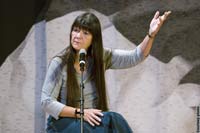This year’s SlideShare “Tell a Story” contest underscored the emergence of of storytelling as a significant component in presentations (even if slide shows aren’t always compatible with good storytelling). (I had thought the “Tell a Story” contest replaced the more generic contest SlideShare held last year but just learned the World’s Best Presentation Contest ’09 has begun accepting entries.)
In recognition of story’s growing role in presentations, I found these 12 interesting bits published recently:
- Listeners go into a trance when they hear a story. So says professional speaker Andy Dooley in a blog entry that is actually not that much about presentations: “Did you know that when you’re listening to a story you go into a trance? Did you know that change happens when you least expect it? Did you know that change happens when you are in a trance?”
- Gestures that go with your story have a specific effect on brain activity. This observation comes from research reported by Bruce Bower in Science News. In the study conducted by neuoscientist Jeremy Skipper, Weill Medical College, Cornell University, and presented in the academic journal Current Biology: “As volunteers listened to and watched a woman who made descriptive hand gestures while telling a story, activity simultaneously increased in one set of brain areas involved in planning and executing actions and in another set thought to underlie language comprehension, the researchers report … These neural systems form a network that ascertains the meaning of gestures accompanying speech, they suggest.” Different brain activity was observed when observers could see a nongesturing woman and when they couldn’t see the woman telling the story.

- You can effectively alter the classic presentation formula by integrating stories. That formula is: Tell ’em what you’re gonna tell ’em. Then tell ’em. Then tell ’em what you just told ’em. Koert Bakker learned to turn that formula on its ear after reading Annette Simmons’ The Story Factor. “This completely changed the way I write presentations now,” Bakker said. “Instead of giving away the key point of the presentation at the beginning, I save it for last. I start with the perspective of the audience, and then take them on a tour of all the aspects that step-by-step convinced me to believe what I believe so they can step-by-step come to believe the same things. And I insert a little drama and tension along the way, to help remember the story and make it easier to pass on.”
- Bullets [probably] can’t help you tell a story. I’ve come to believe bullet points — popularized in presentations by the ubiquitous PowerPoint — serve no real purpose except as memory aids for the presenter. In an article, “The First Five Slides: Unlocking the Story Buried in Your Presentation,” that is packed with lots of good advice about presentations, Cliff Atkinson, says: “When the primary way that we communicate is by presenting lists to one another, it is no wonder that the phenomenon of story is gaining momentum, because a story is the opposite of a list. Where a list is dry, fragmented and soulless; a story is juicy, coherent, and full of life. Presented with the choice, any audience will choose life.” Want another illustration of this point? About 1 minute and 53 seconds into this little video talk by Shawn Callahan, he tells a story that shows how poorly bullet points work compared to stories.
- In fact, ditch the slides. Many a tree and many an electron has given its life in “death by PowerPoint” articles that emphasize not only how PowerPoint kills storytelling in presentations, but how it murders presentations themselves. Joining that chorus is José A. Bowen, dean of the Meadows School of the Arts, who, as reported by Jeffrey R. Young in The Chronicle of Higher Education “has challenged his colleagues to ‘teach naked’ — by which he means, sans machines. More than any thing else, Mr. Bowen wants to discourage professors from using PowerPoint, because they often lean on the slide-display program as a crutch rather using it as a creative tool.” As Young characterizes Bowen’s view: “When students reflect on their college years later in life, they’re going to remember challenging debates and talks with their professors.” Yes, and they will remember the stories their professors told. Some see digital storytelling as the cure for death by PowerPoint, as evidenced by this resource list:
 Digital Storytelling and Reforming PowerPoint
Digital Storytelling and Reforming PowerPoint - Stories stick. In a similar academic vein as the previous point, Joey Asher on his Talking Points blog lamented the terrible presentations he hears at his son’s freshman orientation at the University of Michigan: “Over and over college administrators, health professionals, professors, and public safety professionals would stand up to talk to us about what our kids could expect at the University of Michigan,” Asher said. “And over and over we’d get a series of bullet points, delivered somewhat randomly.” The day was saved by, not an administrator or professor, but a student who described taking an unusual course her freshman year. As Asher writes, quoting the student: “‘I had taken German in high school,” she explained. ‘But when I started looking through the course catalog, I found so many interesting courses, I wanted to take something unusual.'” The something unusual turned out to be Yiddish, and the lesson was that it’s a good idea to take some courses simply because you find them interesting. Said a relieved Asher: “Of all the messages I’ve gotten over the last two days, that message is the one that sticks more than any others. And it’s because it came through a story.” (Shawn Callahan’s story mentioned above under No. 4. also illustrates the stickiness of stories)
- Stories connect your listeners with your topic on a personal level. Citing “a brief slide show at the Consumer Electronics Show in January 2009,” Geoffrey X. Lane wrote that “Palm … put [itself] back into business competition.” You can see the portion of Palm’s “great slide presentation” that Lane refers to here. Wrote Lane: “… notice how Palm’s Jon Rubinstein, like Apple CEO Steve Jobs, treats the presentation like a story. Rather than simply spouting facts about the new phone, he employs narrative (storytelling) to connect listeners to the device on a more personal level — a marvelous marketing strategy involving the audience, and an effective technique you can adopt the next time you appear before the board or your customer.”
- Sequence, unexpected events, and detail can enhance presentation stories. An unnamed blogger at Social Ch@nge cites the “sequence, unexpected events, and detail” in the amusing slideshow below (“An Excellent Boring Presentation” by Ishtiaque Zico). These traits are not exactly applied to a story, but then again, the slideshow can be seen as the story of how to construct a boring presentation. And even if it isn’t, sequence, unexpected events, and detail are still good story devices.
- Make presentation stories simple enough so that audiences can easily repeat them. “Use the power of simplicity to add to your storytelling skills in presenting your ideas, products and solutions,” advises Thomas Sechehaye, who bills himself “The World’s #1 Presentation Storyboard Coach.” In his blog The Next Meeting, he writes, “Training your audience to recall your message happens when you simplify and make it easy for them to tell your story.”
- Road-test your stories. In an article with lots of other good tips, Corey Sommers advises test out stories with trusted people who fit your audience profile: “The question you want to ask is: ‘Does this story resonate with you?'”
- Tell stories about yourself. Carmine Gallo gives an awesome example of using self-stories in a presentation in a Business Week article:
In September 2007, Brad Nierenberg, CEO of RedPeg Marketing in Alexandria, Va., pitched a project to Gaylord National, a massive new resort outside Washington, D.C. He, along with several other members of the team, competed for the account to publicize the hotel’s hiring event the following year. … Nierenberg told me the team members told stories about themselves in the first slides of the pitch, connecting those stories to the roles each would play on the account. For example, the account lead showed a photo of herself as a young cheerleader and discussed how her role is to lead with precision and to keep spirits high. Nierenberg brought a picture of himself as a 6-year old in a cowboy outfit. As the “sheriff” in town, he might not be on the account every day, but he would be available to make sure “all was right in the town of Gaylord.” Nierenberg knew the stories were making on impact on his audience from the smiles on their faces. “They couldn’t wait for the next story,” he said. The attendees even asked for copies of the photos to show the other decision makers. RedPeg won the account.
- On the other hand, tell stories not about yourself but about others. While stories about oneself are great for building trust and connection, Seth Simonds makes a case for telling stories about others, suggesting it may be “possible [to] might find value in telling stories that aren’t about you” (in fact, he offers three reasons to tell stories that aren’t just about you). Simonds cites a Thai Pantene commercial (“Pantene tells us a compelling story with a message we recognize and connect with the shampoo”) and Malcolm Gladwell’s 2004 17.5-minute The Story of Spaghetti Sauce on TED Talks (“Gladwell engages us with a story about a man we can model ourselves after.”)
